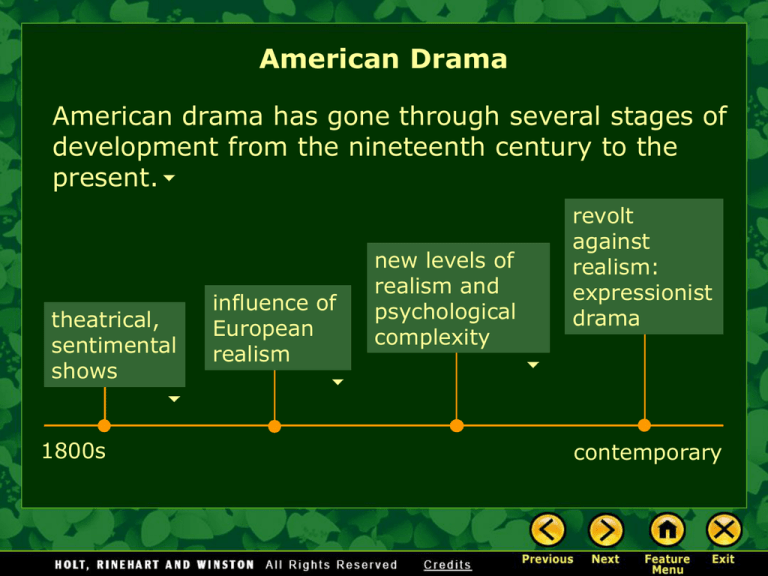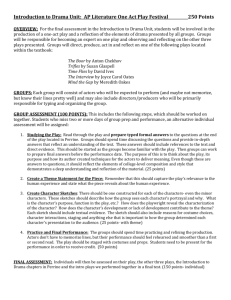Elements of Literature: Character
advertisement

American Drama American drama has gone through several stages of development from the nineteenth century to the present. theatrical, sentimental shows 1800s influence of European realism new levels of realism and psychological complexity revolt against realism: expressionist drama contemporary During the 19th century, melodramas with exemplary democratic figures and clear contrasts between good and evil had been popular. Plays about social problems such as slavery also drew large audiences; sometimes these plays were adaptations of novels like Uncle Tom's Cabin. Not until the 20th century would serious plays attempt aesthetic innovation. Popular culture showed vital developments, however, especially in vaudeville (popular variety theater involving skits, clowning, music, and the like). Minstrel shows, based on African-American music and folkways-- performed by white characters using "blackface" makeup -- also developed original forms and expressions. American Drama European Influences The “slice-of-life” realism of three late-nineteenthcentury European playwrights had a profound influence on American drama. Norwegian Henrik Ibsen depicted unsettling subjects such as guilt, sexuality, and mental illness Swedish August Strindberg brought unprecedented level of psychological complexity to his characterizations Russian Anton Chekhov along with Ibsen and Strindberg, shifted the subject matter of drama to inner actions and emotions and the concerns of everyday life [End of Section] Twentieth-Century Realism Realistic drama is based on the illusion that at a play we are watching life through a “fourth wall” that has been removed so we can see the action. Stage realism is the use of ordinary people, in ordinary settings, using commonplace dialect. The stage props represent a camera photograph. Realistic plays show aspects of real people playing out conflicts and intrigues which reflect the ordinary experiences of American middle class life. Recognizable heroes and villains were replaced with ordinary characters showing ordinary strengths and weaknesses. The replacement of gas light by electricity helped in the creation of realistic ambience. Twentieth-Century Realism Key Figures of American Realism Eugene O’Neill (1888–1953) dominated American drama in his generation Arthur Miller (1915–2005) master of realism; explored social as well as psychological truths in his plays Tennessee Williams (1911–1983) blended realism with imagination; focused on personal rather than social themes [End of Section] Naturalism A commonly interchangeable term with realism, naturalism assumes that humans are controlled by their environment, fate, psychology, chance or coincidence; realistic characters are in control of their destinies. Naturalistic situations are generally pessimistic and deterministic. Trapped and controlled, human behavior is instinctual and animalistic; there is heroism in a human's desire to survive against insurmountable odds. Expressionist Drama Expressionist drama began as a revolt against realism. Rejecting the orderly format of realistic drama, expressionist drama • emphasized stage effects and imaginative settings • focused on revealing characters’ interior consciousness • reflected a sense that life is formless and uncertain Expressionism In expressionistic plays, the playwright's subjective sense of reality finds expression. The characters and the milieu 环 境 may be realistic, but their presentation on stage is controlled by the writer's personal biases and inclinations. No longer a camera photograph, the stage could be highly elaborate or bare; the accompanying lighting, costumes, music, and scenery could be similarly non-realistic. More like a dream, expressionistic writing has no recognizable plot, conflicts, and character developments. However, the threads are still audience friendly; expressionism is not absurdity or an exercise in obscurity. Expressionist Drama Many writers who used expressionist techniques came to be called playwrights of the Theater of the Absurd. • Aburdist plays are not meant to tell a story. • Instead, much like poetry, they use a pattern of images to express an idea or a feeling. Founders of the Theater of the Absurd Expressionist Drama Edward Albee: American Absurdist The most significant absurdist in the United States has been Edward Albee (1928– ). • Albee is not a pure absurdist; he experiments with many forms. The Zoo Story (1959): Albee’s debut The American Dream (1961): an Absurdist play Who’s Afraid of Virginia Woolf? (1962): the play that made Albee famous [End of Section] Contemporary Drama Today, playwrights are free to experiment with many different dramatic forms and structures—as long as their approach speaks compellingly to an audience. Contemporary Drama Quick Check Match each definition with the correct term. drama based on the illusion of watching characters’ lives through an invisible “fourth wall”; themes usually center on contemporary society drama that focuses on revealing characters’ stream of consciousness; replaces logical plot with pattern of poetic images Expressionism Realism [End of Section] Considered the foremost United States playwright, O'N was awarded the Nobel Prize for literature in 1936. He introduced psychological realism in his plays; his constant experimentation with stage craft and acting gave American plays a new vitality and originality. Produced all around the world, his plays continue to attract new generations of readers. O'Neill's earliest dramas concern the working class and poor; later works explore subjective realms, such as obsessions and sex, and underscore his reading in Freud and his anguished attempt to come to terms with his dead mother, father, and brother. Playwright, poet, and fiction writer, Tennessee Williams left a powerful mark on American theatre. At their best, his twenty-five full-length plays combined lyrical intensity, haunting loneliness, and hypnotic violence. He is widely considered the greatest Southern playwright and one of the greatest playwrights in the history of American drama. Born Thomas Lanier Williams on March 26, 1911, he suffered through a difficult and troubling childhood. His father was a shoe salesman and an emotionally absent parent. He became increasingly abusive as the Williams children grew older. His mother, Edwina, was the daughter of Southern Episcopal minister and had lived the adolescence and young womanhood of a spoiled Southern belle. Williams was sickly as a child, and his mother was a loving but smothering woman. In 1918 the family moved from Mississippi to St. Louis, and the change from a small provincial town to a big city was very difficult for William¹s mother. Williams had an older sister named Rose and a younger brother named Walter. Rose was emotionally and mentally unstable, and her illnesses had a great influence on Thomas¹s life and work. Tennessee Williams did not express strong admiration for any early American playwrights; his greatest dramatic influence was the brilliant Russian playwright Anton Chekhov. Chekhov, with his elegant juxtaposition of the humorous and the tragic, his lonely characters, and his dark sensibilities, was a powerful inspiration for Tennessee Williams' work although Williams' plays are undeniably American in setting and character.




